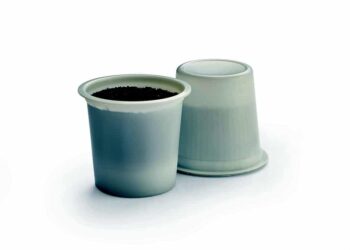In the fight against plastic, great attention has been paid to the terrestrial waste that finds its way to our oceans through landfill and littering. Schemes around the world have targeted disposable waste ranging from plastic straws to coffee cups, and now even supermarket packaging is being overhauled with biodegradable alternatives. But what about the plastic designed for use in our oceans? Once taken out to sea, it’s easy to lose track of the plastic nets and ropes used in commercial and small-scale fishing voyages and once discarded, this detritus poses one of the most significant threats to marine life.
So called ‘ghost gear’ – nets and other equipment that are either lost or abandoned – have been identified as items of ‘particular concern’ as part of the European Directive on Single-Use Plastics. Finding sustainable alternatives is a priority for cleaning up our oceans, and while it’s a market still in development, there are some companies on the cusp of revolutionising the marine plastic industry.
The plastic problem
Ghost nets currently contribute 640,000 tonnes of marine waste every year. A 2019 Greenpeace report found that in total, abandoned fishing nets and gear make up 10% of the plastic waste in the sea – endangering marine life and ecosystems around them as it brings with it the risk of entanglement, as well as leaching toxins into the surrounding water. Most modern nets are made of nylon or other plastic compounds, and given the length of time needed for these materials to break down the problem is one that lingers on in our oceans for decades.
Most recently, abandoned nets were retrieved from coral reefs in the Gulf of Thailand in what was a two day operation involving forty divers. The nets – which were discovered in the protected area around Ko Losin – were found to have caused bleaching along the coral it had draped across, and had reportedly been left in the province for a month and a half. In Hawaii, a hotline has been set up to report sightings of ghost nets, with any abandoned gear to be taken to Hawaii Pacific University’s Center for Marine Debris Research. The Center is working on sending ghost gear back to where it originated.
While necessary, these efforts only remedy the symptoms of the problem – not the cause. To effectively and significantly reduce ghost gear, developing biodegradable alternatives to traditional plastic fishing equipment is a key way to get there. And it is a market that is seeing some traction.
Biodegradable nets
Traditional nylon nets are still more cost effective than their biodegradable counterparts, but research and development schemes are emerging around the world that are seeking to change this.
One such company is SEALIVE – a €10.26 million European Union Horizon 2020-funded Innovation Action project set up to reduce plastic pollution and boost uptake of biomaterials. Under the scheme, researchers have developed bio-based fishing nets made from micro-algae and other organic materials.
Prototypes of the nets are currently being tested by local fishermen in Paphos, Cyprus. For the project, SEALIVE is partnering with the NGO AKTI Project and Research Centre, as well as the environmental research and consultancy ISOTECH Ltd. Results from the pilot test – which is set to last for 12 months – will help to evaluate the efficacy and operability of the nets, and inform the project’s next steps.
Speaking with Christina Baldwin from AKTI and Demetra Orthodoxou from ISOTECH, they say that while there is minimal data quantifying the amount of ghost gear in the area, operations in the region show the problem is substantial.
“AKTI has been working with fishermen and divers around the island for the past 20 years,” they say. “Part of this work involves seabed cleanup activities to remove ghost nets and other derelict fishing gear. Our experience suggests that the problem is significant, with ghost nets/gear congregating on reefs and underwater trenches.”
The groups will also work alongside environmental research and consultancy SME to monitor the nets’ structural integrity and operational efficiency.
“ISOTECH will receive regular feedback from the involved fishermen to record their experience with using the nets, to ultimately evaluate their acceptability and identify any issues of concern,” they say. “This information will allow the SEALIVE project to make any necessary improvements to this product. If this pilot application is successful, the next steps will be the commercialisation of the fishing nets.”
Samples have also been sent to partners Cittadini and Seabird in France, who will use them to design the new biodegradables nets. These will themselves also be sent to Cyprus for testing once completed.
Other marine waste solutions
Baldwin and Orthodoxou say that in addition to creating sustainable solutions, better legislation around disposing of traditional fishing gear is needed to combat the issue.
“As with everything else, prevention is key and should be our main goal,” they say. “One way to prevent purposeful disposal of old, unused fishing nets is by allowing fishers to dispose of this equipment free of charge. Sometimes the excessive cost of disposal, especially as compared to the relatively low income of (mainly) artisanal fishers, can be a strong disincentive for appropriate disposal.”
“Developing markets for old, unused fishing gear is also very important,” they add, “as it not only promotes the concept of the circular economy, but it also gives value to this waste, encouraging its appropriate disposal and even its collection/cleanup from the seabed.”
Indeed, projects are emerging that look to repurpose ghost gear pulled from the sea. California-based Bureo melts recycled fishing gear and remoulds it to make plastic pellets. These are in turn used to make new consumer products such as skateboards, sunglasses and toys. Burero currently has 26 fishing communities throughout Chile involved in sourcing the abandoned gear, and since 2013 the company has seen 185 tonnes of waste nets collected.
Education around the dangers of ghost gear is also a vital piece in targeting the issue, and research projects are emerging elsewhere to meet this gap in the market. For instance, a new centre for research-based innovation, dubbed DSOLVE, is being established at the University of Tromsø in Norway. The new centre was established to investigate more eco-friendly solutions to plastic fishing gear, and the researchers will be conducting tests comparing biodegradable plastic materials with conventional polymers.
While the danger of ghost gear is a severe one, the new spotlight on growing tides of plastic means that investment and research into targeting the problem are on the up. With rapid technological advancements making sustainable alternatives more viable, the next step is to bring these products into commercial use, and make them economically competitive with traditional nylon models. While the issue has not yet been solved, such industry developments imply the sector may be headed to clearer waters.

















